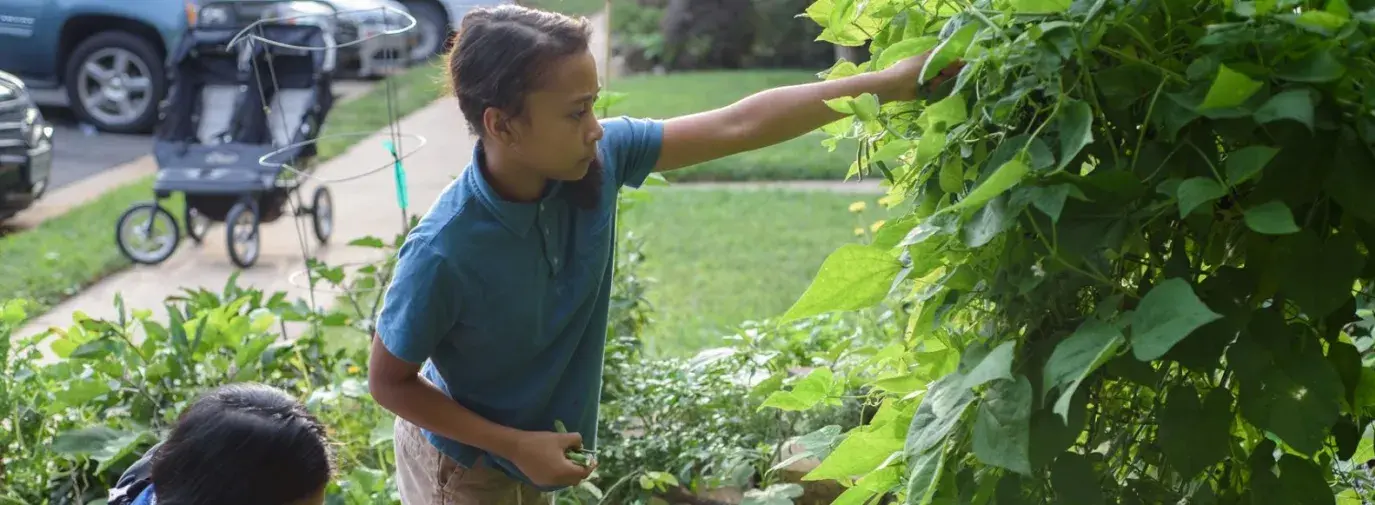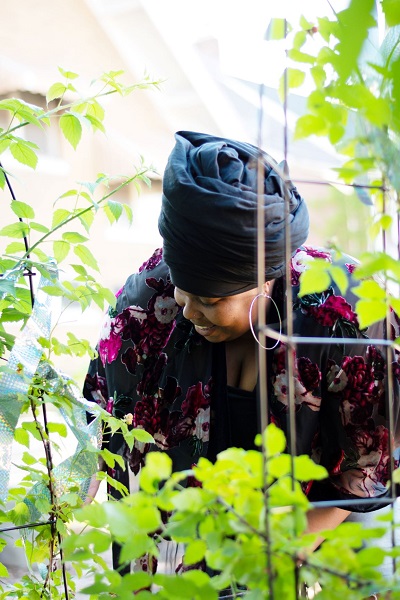
The American dream’s stereotype is a house with a white picket fence, with a lush green lawn for playing fetch with the dog and seeing baby’s first steps.
Except today’s American dream is green—and having a large expanse of lawn just isn’t. Across the country, people are realizing that a traditional grass lawn isn’t sustainable. The EPA estimates that 9 billion gallons of water a day are used on lawns and 17 million gallons of gas are used in mowers every year; these practices simply aren’t sustainable.
But not everyone is ready to make the switch. Green America frequently fields letters from our members about what to do if your Homeowners' Association (HOA) or neighborhood pushes back when you make the switch to a greener green space. We talked to Climate Victory Gardeners who had first-hand experience.
Gary, Indiana v. Aja Yasir
In 2019, Climate Victory Gardener Aja Yasir made headlines when she converted her Gary, Indiana, front yard into a small climate victory garden—a garden that uses Earth-friendly planting and tending practices for the good of the soil and therefore, the climate. For some, her new garden looked like a new homeowner moving into their property, but to Yasir’s city, it was seen as a visual burden. She was cited for having woodchips on her yard as part of converting the lawn to a garden. Her house had sat vacant for years before she purchased it and she was doing her best to renew the property, she says.
“I have no problem with my neighbor complaining because they didn’t know what was going on. They’re not a gardener, they don’t do urban farming,” Yasir says. “But for me, for a government to come against people who are growing food, trying to restore the environment and the soil and water, and the pollinator habitats—for a government to come against that, is criminal.”
Yasir’s case was in legal limbo for six months in 2019. It finally settled out of court in October 2019 and she was free to garden, with some restrictions agreed upon in the settlement, in 2020.
Then the world shut down. Yasir, whose garden is called “A Rose for Yaminah” in honor of her daughter who died in 2016, uses her garden for grief and anxiety relief. The pandemic also created its own level of grief and anxiety, so she was glad to be allowed to garden freely again.
“I could go into my garden. I could look at all these flowers. I can be amongst all this fruit, all this these vegetables. I can just touch the soil, I can gather rainwater, and I just felt so at peace,” Yasir says. “And that’s actually what I was looking for.”

HOA v. The Schauders
Nicky Schauder owns Permaculture Gardens {GBN}, a small business that helps people design home gardens that grow food, with her husband in Sterling, Virginia. There they have a garden in the front- and backyard of their townhouse, where the family of eight has lived for 15 years. Schauder says just about every year she gets a letter from her HOA saying that some part of her front garden is not allowed—be it vegetables, fruited vines, or moss. It can be incredibly frustrating, she says.
She recommends keeping communication lines open between a home gardener and their HOA and cultivating relationships with neighbors who support you.
She wrote a letter to her HOA explaining why a garden was good for her family and the community, citing many neighbors who interacted with it and supported it. She also recommends and hosts classes on “edible landscaping,” which means gardening with subtle plants that look more like ornamental landscaping.
Yasir agrees that disguising her garden as an ornamental one has been the tactic that ultimately worked. She recommends flowering herbs and edible flowers, like hibiscus, artichokes, berry bushes, turmeric, and multi-colored tomato varieties.
Both Schauder and Yasir were advocates for their gardens and were able to leverage support from community members to be able to have the food to feed their families.
“If you find yourself in the middle of that fight, if you have the energy, because self-care is number one, please keep fighting because this is very serious work. Gardeners are very serious workers,” Yasir says. “Like Ron Finley has said, this is not a hobby. This is real work, so just keep up the fight.”
See Ron Finley talk more about gardening in a video
Join the Movement, Step by Step
If you’re not ready to fully jump into a life without green grass to wiggle your toes in, that’s ok. Here are some steps to take to make your green space greener that probably won’t cause a stir.
Baby Steps:
Grow a freedom lawn: Stop using pesticides or fertilizers on your lawn and see what grows. What comes up and sticks around will likely be more suited to the precipitation and climate in your region.
Mow only where you need: Mow a walking path or an area around lawn furniture, but is there a place you mow but don’t go? Let nature thrive there or do an intentional planting there.
Swap your mower: Are you still mowing with a dirty gas-powered mower? Their two-stroke engines contribute an alarming amount to air pollution, as well as noise pollution in your neighborhood. Learn how to swap it in 5 Steps to A More Sustainable Backyard.
Big Steps:
Plant a tree: A tree gives more bang for your climate buck, as it lives longer, sequesters carbon for longer, and provides more habitat for birds and insects.
“You always start with one plant. And if you can plant a tree, that’s the most powerful thing you can do,” Heather McCargo, founder and exectutive director of The Wild Seed Project, says. “Then you can put a native ground cover underneath it.”
Swap your ground cover: Once you have a tree in the ground, it’s still just a tree surrounded by grass. Consider swapping ground cover for part of your yard to further reduce the mowable section. Search the web for “native ground cover” and your state to find species that will thrive in your climate, will attract native pollinators, and are not invasive.
Be patient, as gardeners say about groundcover plants, “the first year they sleep, the second year they creep, and the third year they leap.”
Giant steps:
Plant a climate victory garden in part of your yard. We share steps for beginners and expert gardeners at Climate Victory Gardens.
Make it a meadow: The Wild Seed Project promotes turning your lawn into a native wildflower meadow but McCargo says it’s not as easy as growing food or a tree.
The hottest months of the year would be a great time to lay black plastic over your yard to kill grass and be able to have a clean slate next growing season, McCargo says. Or, if you’re planning a garden next season, smother that part of the lawn with cardboard and mulch now.
When the outdoor space you call your own is more dynamic and diverse than a flat green lawn, you're creating something greater than the stereotype. Even if you have to fight pushback for garden or groundcover, the American dream is green, and your food garden, local habitat, or outdoor oasis deserves to be part of it.







